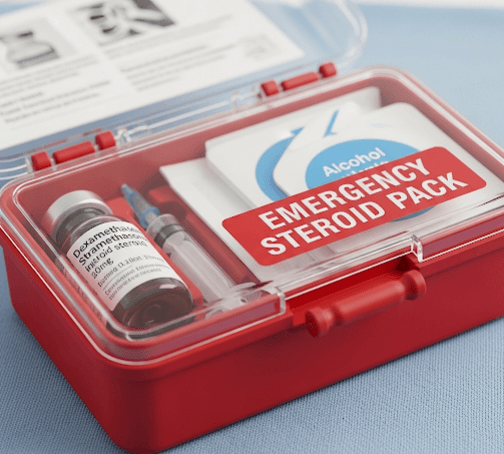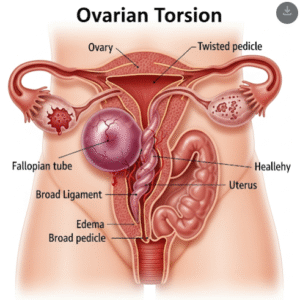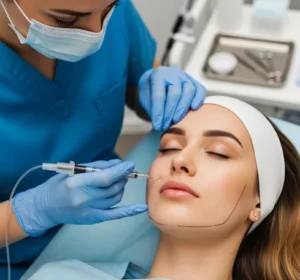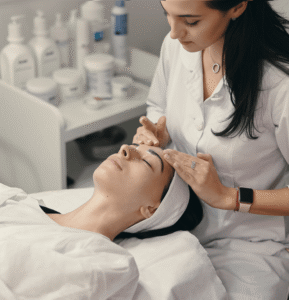What it is
→ An emergency steroid pack is a prescribed set of oral corticosteroid medications (often in tapering doses) intended for short-term use during acute flare-ups of inflammatory or allergic conditions.
→ It is commonly given to patients with autoimmune disorders, severe allergies, asthma, eczema, psoriasis, or sudden inflammatory reactions to quickly reduce swelling, pain, or immune overactivity.
→ These packs are sometimes called steroid dose packs or burst therapy, and they usually contain prednisone or methylprednisolone tablets arranged in a specific dosing schedule.
→ In dermatology and cosmetic practice, an emergency steroid pack may also be prescribed for severe injection reactions, filler-related inflammation, or post-laser swelling.
Why it’s done
→ An emergency steroid pack is used to:
- Rapidly control inflammation in flare-ups of chronic conditions (psoriasis, eczema, lupus, etc.).
- Treat acute allergic reactions, such as severe hives or angioedema.
- Reduce airway inflammation in asthma or bronchitis attacks.
- Manage severe swelling or pain after medical or cosmetic procedures.
- Prevent progression of potentially dangerous immune reactions.
→ The goal is to provide short-term, fast relief, while avoiding long-term steroid complications.
Alternatives
→ Alternatives to an emergency steroid pack depend on the underlying condition:
- Antihistamines → for mild allergic reactions.
- Nonsteroidal anti-inflammatory drugs (NSAIDs) → for mild inflammation and pain.
- Topical steroids → for localized skin inflammation instead of systemic steroids.
- Biologics or immunosuppressants → for chronic autoimmune disease management.
- Supportive care → oxygen, inhalers, or epinephrine for certain emergencies.
→ However, in sudden or severe flare-ups, systemic steroids remain the fastest and most reliable option.
Preparation
→ Before using an emergency steroid pack, patients should:
- Have a clear prescription and instructions from a physician.
- Review medical history → inform the doctor of diabetes, hypertension, infections, or osteoporosis (as steroids can worsen these conditions).
- Know the tapering schedule → steroid packs are typically pre-arranged in a step-down dosing pattern (e.g., 24 mg → 20 mg → 16 mg, etc.).
- Avoid NSAID overuse → combining with steroids can increase risk of stomach irritation.
- Prepare gastric protection → sometimes proton pump inhibitors are prescribed alongside steroids.
How it’s Done
→ A standard emergency steroid pack is taken as follows:
- Day 1 → higher initial dose to quickly suppress inflammation.
- Day 2–6 (or longer, depending on pack) → gradually reduced daily doses to taper off safely.
- Exact schedule → varies depending on the drug (e.g., Medrol Dosepak contains 21 tablets of 4 mg methylprednisolone for a 6-day taper).
→ Key points:
- Always take with food to prevent stomach irritation.
- Follow the exact dosing order indicated in the pack.
- Never abruptly stop mid-pack unless directed by a doctor.
- If symptoms worsen, contact a healthcare provider immediately.
Recovery
→ Recovery with an emergency steroid pack is generally quick, as the medication acts within hours to days:
- Allergic reactions → swelling and redness often improve within 24–48 hours.
- Autoimmune flare-ups → pain, rash, or joint inflammation improves within a few days.
- Post-procedure inflammation → reduced swelling and discomfort typically noticeable within 1–2 days.
→ After the taper is complete, most patients return to their baseline condition.
→ Follow-up with the prescribing physician may be required to ensure symptoms are fully controlled.
Complications
→ Short-term steroid use is generally safe, but possible side effects include:
- Stomach upset, nausea, or heartburn.
- Increased appetite.
- Mood changes, irritability, or insomnia.
- Temporary rise in blood sugar or blood pressure.
→ Rare complications (usually with repeated or prolonged use):
- Weakened immunity.
- Weight gain and fluid retention.
- Bone thinning (osteoporosis).
- Adrenal suppression if used too frequently.
→ Patients should not use emergency steroid packs repeatedly without medical supervision, as long-term misuse can cause serious complications.
Treatment options in Korea
→ Korea offers structured emergency steroid management in both hospitals and dermatology clinics.
- University hospitals and dermatology centers → prescribe steroid packs for autoimmune flare-ups, allergic reactions, and severe skin inflammation.
- Cosmetic dermatology clinics → may use short steroid packs for severe post-injection or post-laser swelling under close monitoring.
- Strict medical regulation → steroids are not available over-the-counter; they must be prescribed and monitored.
- Customized treatment → Korean physicians often pair steroid packs with antihistamines, antibiotics, or proton pump inhibitors when needed.
- Holistic approach → follow-up visits ensure patients transition back to non-steroidal long-term management.
- Medical tourism support → international patients with chronic inflammatory conditions can access Korean specialists for structured flare-up care.
→ With Korea’s strong medical infrastructure and emphasis on safe prescribing, emergency steroid packs are used effectively while minimizing risks.













